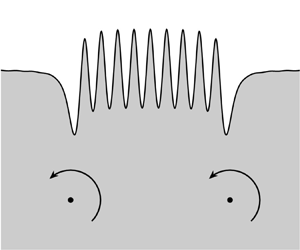Published online by Cambridge University Press: 06 March 2023

There has been significant recent interest in the study of water waves coupled with non-zero vorticity. We derive analytical approximations for the exponentially small free-surface waves generated in two dimensions by one or several submerged point vortices when driven at low Froude numbers. The vortices are fixed in place, and a boundary-integral formulation in the arclength along the surface allows the study of nonlinear waves and strong point vortices. We demonstrate that, for a single point vortex, techniques in exponential asymptotics prescribe the formation of waves in connection with the presence of Stokes lines originating from the vortex. When multiple point vortices are placed within the fluid, trapped waves may occur, which are confined to lie between the vortices. We also demonstrate that, for the two-vortex problem, the phenomenon of trapped waves occurs for a countably infinite set of values of the Froude number. This work will form a basis for other asymptotic investigations of wave–structure interactions where vorticity plays a key role in the formation of surface waves.